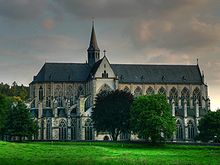Altenberg Abbey
- View a machine-translated version of the German article.
- Machine translation, like DeepL or Google Translate, is a useful starting point for translations, but translators must revise errors as necessary and confirm that the translation is accurate, rather than simply copy-pasting machine-translated text into the English Wikipedia.
- Do not translate text that appears unreliable or low-quality. If possible, verify the text with references provided in the foreign-language article.
- You must provide copyright attribution in the edit summary accompanying your translation by providing an interlanguage link to the source of your translation. A model attribution edit summary is
Content in this edit is translated from the existing German Wikipedia article at [[:de:Abtei Altenberg]]; see its history for attribution. - You may also add the template
{{Translated|de|Abtei Altenberg}}to the talk page. - For more guidance, see Wikipedia:Translation.


Altenberg Abbey (Abtei Altenberg) (Latin: Vetus Mons) is a former Cistercian monastery in Altenberg, now a part of the municipality of Odenthal in the Bergisches Land, North Rhine-Westphalia, Germany.
History
The abbey was founded in 1133 as a daughter house of Morimond Abbey and settled initially in the old castle of the Counts of Berg, Burg Berge, which the counts had left for Schloss Burg, but moved to the new purpose-built monastery in the valley of the Dhünn in 1153.[2] It flourished sufficiently to undertake the settlement of a number of daughter houses of its own: Mariental Abbey and Wągrowiec Abbey, both in 1143; Ląd Abbey in 1146; Zinna Abbey in 1171; Haina Abbey in 1188; Jüterbog Abbey in 1282; and Derneburg Abbey in 1443.
In 1803 it was dissolved during the secularisation of Germany and fell into ruin. Starting in 1847 under King Frederick William IV of Prussia, a thorough restoration was carried out, and the restored church, known as the Altenberger Dom ("Altenberg Cathedral", although Altenberg was never the seat of a bishopric so this is not technically accurate), is currently an interdenominational church used by both Roman Catholics and Protestants.
Burials
- William VII of Jülich, 1st Duke of Berg
- Gerhard VI of Jülich, Count of Berg and Ravensberg
- Margaret of Ravensberg
- Adolf IV, Count of Berg
- Frederick II (Archbishop of Cologne)
- William IV, Duke of Jülich-Berg
- Sibylle of Brandenburg
- Bruno III of Berg
Notes
- ^ See manuscript MS-D-34 – Antiphonale (pars hiemalis) of University and State Library Düsseldorf, p. 88, created c. 1550.
- ^ Norbert Orthen: Unter dem Zeichen der Jakobsmuschel. Altenberg – eine Station auf dem Jakobusweg. (online Archived 2009-10-20 at the Wayback Machine)
References
- Breidenbach, Nicolaus J., 2006: Die Abtei Altenberg - Ihre Güter und Beziehungen zu Wermelskirchen in: Altenberger Blätter, Nr. 35, Odenthal 2006
- Breidenbach, Nicolaus J., 2006: Die Schenkung des Hofes Steinhausen in: Altenberger Blätter, Nr. 35, Odenthal 2006
- Ermert, H., 1924: Der ländliche Grundbesitz der Abtei Altenberg bis zum Ende des 15. Jahrhunderts. Dissertation. Bonn, 1924
- Mosler, Hans: Urkundenbuch der Abtei Altenberg. Vol. I, Düsseldorf, 1912; Vol. II, 1950
- Redlich, Paul 1901: Die letzten Zeiten der Abtei Altenberg in Annalen des Historischen Vereins für den Niederrhein, 72. Jg, 1901, pp. 102–141 (online) (in German)
External links
 Media related to Kloster Altenberg at Wikimedia Commons
Media related to Kloster Altenberg at Wikimedia Commons
- Altenberg Abbey on Cistopedia – Encyclopædia Cisterciensis
Legends and tales
- Die Brüder vom Berge oder die Gründung des Klosters
- Die Neugründung des Klosters Altenberg
- Die Rosen zu Altenberg
- Der Wasserteufel bei Altenberg
- Die Nachtigallen im Kloster zu Altenberg
- Der Ave-Marien-Ritter zu Altenberg











